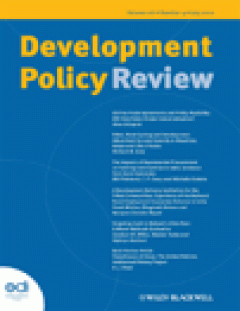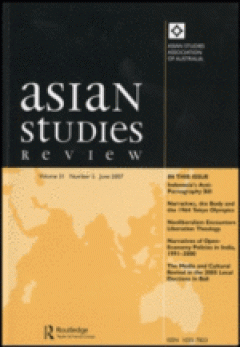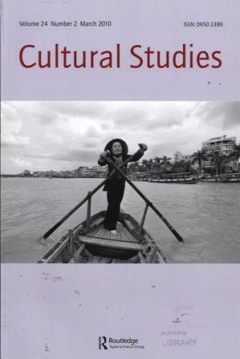Filter by

The Impacts of Supermarket Procurement on Farming Communities in India: Evide…
The rapid expansion of supermarket retailing, with its impact on farmer communities, represents a contentious part of India's recent economic development. This article reports on three districts of Karnataka, where a survey of 78 farmers supplying fruits and vegetables to Reliance Fresh, a leading supermarket chain, reveals low levels of vertical co-ordination, a lack of written contracts, and …
- Edition
- Volume 28 Issue 4, July 2010. Pages 435 - 456
- ISBN/ISSN
- 09502386
- Collation
- -
- Series Title
- Development Policy Review
- Call Number
- -

A Development Delivery Institution for the Tribal Communities: Experience of …
This article examines the varied impacts of the National Rural Employment Guarantee Scheme (NREGS) as a development delivery institution for the tribal communities vis-�-vis other social groups across the Indian States, using the framework of new institutional economics. A number of State-specific, socio-economic institutional factors seem to be responsible for these variations. The article the…
- Edition
- Volume 28 Issue 4, July 2010. Pages 457 - 479
- ISBN/ISSN
- 09502386
- Collation
- -
- Series Title
- Development Policy Review
- Call Number
- -

Targeting Cash to Malawi's Ultra-Poor: A Mixed Methods Evaluation
Governments target transfers so that limited resources reach impoverished households; targeting errors therefore indicate inefficiency in resource use and inability to reach the poorest households. This article examines the Malawi Social Cash Transfer Scheme (SCTS), using mixed methods and multiple data sources, including examination of underlying assumptions, the operationalisation of key conc…
- Edition
- Volume 28 Issue 4, July 2010. Pages 481 - 502
- ISBN/ISSN
- 09502386
- Collation
- -
- Series Title
- Development Policy Review
- Call Number
- -

The State and the New Society: The Role of the Arts in Singapore Nation-building
This paper takes an historical perspective on the trajectory of Singapore's arts and cultural landscape from 1965 to 2000. It examines the arts and cultural field as an ideological site within which the People's Action Party government constantly sought to reinvent or vision a new society. From harnessing the arts for the task of creating �civilised� and �cultured� citizens immediately after in…
- Edition
- Volume 34, Issue 2 June 2010 , pages 131 - 149
- ISBN/ISSN
- 10357823
- Collation
- -
- Series Title
- Asian Studies Review
- Call Number
- -

Pontianaks, Ghosts and the Possessed: Female Monstrosity and National Anxiety…
In its self-conscious transformation into a global city with a national culture that strains to include post-industrial values, contemporary Singapore has had to struggle with the repressed anxieties that threaten to return and disrupt its entry into the advanced stages of global capitalism. This article argues that such struggles are ritually performed in a selection of contemporary Singapore …
- Edition
- Volume 34, Issue 2 June 2010 , pages 151 - 170
- ISBN/ISSN
- 10357823
- Collation
- -
- Series Title
- Asian Studies Review
- Call Number
- -

Singapore FHM: State Values and the Construction of Singaporean Masculinity i…
Transnational magazines have enjoyed enormous success with readers in Singapore in recent years. But what hurdles are faced by these syndicated magazines as they attempt to enter global markets? This article explores the difficulties of meeting audience demands while obeying strictly monitored rules set down by the state. Drawing from initial research into women's lifestyle magazines, this arti…
- Edition
- Volume 34, Issue 2 June 2010 , pages 171 - 190
- ISBN/ISSN
- 10357823
- Collation
- -
- Series Title
- Asian Studies Review
- Call Number
- -

Sport and the Theatrics of Power in a Postcolonial State: The National Games …
The National Games of 1961 and 1964 transformed the theatrics of state power in postcolonial Laos. While using modern sporting spectacle to promote national unity and progress in a context of Cold War division, the games were also embedded in an existing theatrics of power, which dramatised the status of their founder, General Phoumi Nosavan. The modern motifs of national unity and progress wer…
- Edition
- Volume 34, Issue 2 June 2010 , pages 191 - 210
- ISBN/ISSN
- 10357823
- Collation
- -
- Series Title
- Asian Studies Review
- Call Number
- -

The Value of Bodies: Deception, Helping and Profiteering in Human Trafficking…
Over the last two decades, increasing attention has been given to trafficking in persons globally. Governments, international organisations and the media generally assume that trafficking is immensely profitable. This paper problematises this assumption in light of ethnographic research within the sex industry along the Thai-Lao border. It argues that the cross-border recruitment of Lao women i…
- Edition
- Volume 34, Issue 2 June 2010 , pages 211 - 229
- ISBN/ISSN
- 10357823
- Collation
- -
- Series Title
- Asian Studies Review
- Call Number
- -

Informality in the Philippine Civil Service
Philippine political and bureaucratic organisations are usually presented as weak, permeable, distorted and corrupt and, as such, lie some way from a proper condition of formality. There is no question that informal behaviour can and does have a deleterious effect on the civil service and the organisations it staffs. But it is also clear that, within the bureaucracy, there is a deal of positive…
- Edition
- Volume 34, Issue 2 June 2010 , pages 231 - 251
- ISBN/ISSN
- 10357823
- Collation
- -
- Series Title
- Asian Studies Review
- Call Number
- -

History, Silence and Homelessness in Contemporary Chinese Cinema: Wang Xiaosh…
Set a few years after China's opening to the various forces of globalisation, the film Shanghai Dreams (2005) tells the story of the conflict between Qinghong, a 17 year-old schoolgirl who wishes to remain in her hometown of Guiyang, and her father, Lao Wu, whose dream of returning to his hometown of Shanghai is stirred by reports of the better life others have obtained as a result of Deng Xiao…
- Edition
- Volume 34, Issue 1 March 2010 , pages 3 - 18
- ISBN/ISSN
- 10357823
- Collation
- -
- Series Title
- Asian Studies Review
- Call Number
- -

Translating Japanese Adult Movies in Taiwan: Transcending the Production-Cons…
This paper is an attempt to reconsider the opposition between consumption and production in social sciences through a detailed analysis of the production of Chinese subtitles for a pirated Japanese adult video (AV) clip in Taiwan. We demonstrate that the way local pirate merchants provide Chinese subtitles is very much guided by the sexual roles of men and women, or what Sahlins calls a cultura…
- Edition
- Volume 34, Issue 1 March 2010 , pages 19 - 39
- ISBN/ISSN
- 10357823
- Collation
- -
- Series Title
- Asian Studies Review
- Call Number
- -

Culture, Literature and the Contradictions of Socialist Capitalism in Chinese…
Most large Chinese corporations publish e-magazines to which employees are encouraged to contribute on various topics, ranging from management and work issues to creative writing and other creative �cultural� work such as poetry, calligraphy and photography. These e-magazines provide a central venue where employees can learn about what is important to the firm's management. They are one of the …
- Edition
- Volume 34, Issue 1 March 2010 , pages 41 - 61
- ISBN/ISSN
- 10357823
- Collation
- -
- Series Title
- Asian Studies Review
- Call Number
- -

Fat, Spices, Culture and More: Chinese Food in Postwar Japanese Gastronomic W…
Chinese cooking is popular in contemporary Japan. It is also a favourite subject of gastronomic writings that discuss not only the cooking techniques and ingredients but also the cultural meaning of the cuisine. This paper analyses the central concerns of this literature and points out its broader cultural-political implications. It contends that Japanese writings on Chinese food share a set of…
- Edition
- Volume 34, Issue 1 March 2010 , pages 63 - 81
- ISBN/ISSN
- 10357823
- Collation
- -
- Series Title
- Asian Studies Review
- Call Number
- -

Mainland Chinese Family Caregiver Narratives in Mental Illness: Disruption an…
This study employs a phenomenological hermeneutic approach to analyse narratives written by mainland Chinese people who care for a family member with serious mental illness. Locating culture at the centre of the analysis, the study explicates and explores the salient themes and subthemes in texts that were originally published in a monthly psychoeducational newsletter. Analysis reveals that men…
- Edition
- Volume 34, Issue 1 March 2010 , pages 83 - 103
- ISBN/ISSN
- 10357823
- Collation
- -
- Series Title
- Asian Studies Review
- Call Number
- -

MODERNITY AND COMMENSURATION: A reading of a contemporary (economic) crisis
This piece considers the financial crisis of 2008 through the lens of the derivative, by locating both the derivative and the crisis in the broader context of post-war US conjuncture. Drawing upon the work of Marx, Postone and von Mises, I argue that the derivative can be seen as a response to the collapse of any viable logic of commensuration. Its failure has to be understood, again, in the co…
- Edition
- Volume 24, Issue 3 May 2010 , pages 295 - 332
- ISBN/ISSN
- 09502386
- Collation
- -
- Series Title
- Cultural Studies
- Call Number
- -

THE LOST HISTORIES OF AMERICAN ECONOMIC RIGHTS
This article examines the concept and the discontinuous historical usage of the term 'economic rights' in American political discourse from the perspective of democratic political freedom. It views the idea and ideology of 'economic rights' as a discursive marker pointing to historically contingent relations between government, national economy and individual freedom. It focuses on the only two…
- Edition
- Volume 24, Issue 3 May 2010 , pages 333 - 355
- ISBN/ISSN
- 09502386
- Collation
- -
- Series Title
- Cultural Studies
- Call Number
- -

SPIRITS IN THE NIGHT: Reasonableness and the etho-politics of securities law
As the faith in a rational and efficient market collapses there has been a frantic search to account for the irrational motives underwriting economic behavior. A new popular discourse of economics grounded in behaviorism, models of social contagion, and the sociobiology of affect has emerged. We focus on one particularly influential instantiation of this new discourse, George Akerlof and Robert…
- Edition
- Volume 24, Issue 3 May 2010 , pages 356 - 374
- ISBN/ISSN
- 09502386
- Collation
- -
- Series Title
- Cultural Studies
- Call Number
- -

AFTER NEO-LIBERALISM?: Markets, states and the reinvention of public welfare
This paper explores some aspects of the present crisis, including the problem of how to think about crises in the current conjuncture. It has four main parts: the first and second explore the changing imagery of markets as disenchantment sets in; the third considers what sort of crisis is taking place; and the fourth and final part of the paper considers how innovations and interventions direct…
- Edition
- Volume 24, Issue 3 May 2010 , pages 375 - 394
- ISBN/ISSN
- 09502386
- Collation
- -
- Series Title
- Cultural Studies
- Call Number
- -

CELEBRITY AND SCHADENFREUDE: The cultural economy of fame in freefall
This paper explores the popularity of contemporary expressions of delight in celebrity downfall, or Schadenfreude towards celebrity culture, and questions to what extent they can be understood as cultural critiques of economic inequality. For just as the economy has its own parables, so do 'cultural' expressions contain parables of normativity about economic life. We argue that Schadenfreude's …
- Edition
- Volume 24, Issue 3 May 2010 , pages 395 - 417
- ISBN/ISSN
- 09502386
- Collation
- -
- Series Title
- Cultural Studies
- Call Number
- -

TAXI CAB PUBLICS AND THE PRODUCTION OF BROWN SPACE AFTER 9/11
This paper introduces Brown Space as a conceptual category to understand the particular spatial politics of Brown as an 'identificatory strategy' after 9/11. I use the taxi cab and the daily life of the 'brown' taxi driver as a vehicle to navigate the new micro-politics of brown in public space. Within the popular imaginary I locate two dominating configurations of the taxi post-9/11 which work…
- Edition
- Volume 24, Issue 2 March 2010 , pages 183 - 199
- ISBN/ISSN
- 09502386
- Collation
- -
- Series Title
- Cultural Studies
- Call Number
- -
 Computer Science, Information & General Works
Computer Science, Information & General Works  Philosophy & Psychology
Philosophy & Psychology  Religion
Religion  Social Sciences
Social Sciences  Language
Language  Pure Science
Pure Science  Applied Sciences
Applied Sciences  Art & Recreation
Art & Recreation  Literature
Literature  History & Geography
History & Geography